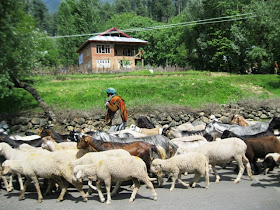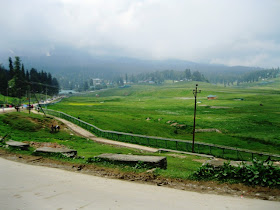On our return from Gulmarg, we were
lodged in a House Boat with all amenities. The location was away from the
madding crowd at a serene Nageen (Nagin) lake. The house boat itself was named
“Peace of Mind”. It was not very difficult to get a House Boat in the Dal Lake
which is the general choice. Then it seemed that the Dal Lake is too much
crowded and you are saddled with the problem of so many vendors calling on you
in their boats. After settling down, we enjoyed some late evening views of the
lake and then went for our dinner. Dinner was arranged in another floating
restaurant nearby. In fact Nageen lake is also a part of the famous Dal Lake
separated by a bund.
Our house boat was anchored (should rather say grounded) on the Eastern Bank of the lake. Early morning we could only see, the Sun rays falling on the lake waters and beyond and a beautiful view of the Hill opposite (Hari Parbat) over which a fort stood. Some people in boats were busy fishing deep inside as also closer to its banks. In between Stray flower vendors did visit us in their boats. After enjoying the views from the boat, we were at the table in the dining area for our breakfast. After the breakfast we were on Shikaras (boats with a canopy) for a two hour trip. Ours oarsman was one Mr. Shafi and amidst his renderings of ethnic songs. we sailed through the still waters.
While we were still enjoying the traditional songs sung by Mr. Shafi, another boat with merchandise drew closer to us. He wanted to show us various items made of Papier-mâché for which Kashmir is well known. We had seen them earlier at various curio shops at Srinagar and elsewhere. We also had an idea of the prices of certain items. Our ladies had a dig and also obliged him by purchasing few pieces about which they were comfortable. It is customary for the Kashmiri traders to quote more than 100% of the real price and they know for certain that the gullible tourist may not seek a reduction of over 50%. Therefore logically the fair price should be around 40% of what he has quoted. When the other boat was away Mr. Shafi consoled the men folk stating that, had we been in the Dal Lake, we could not have had time to move around as we will be confronting some one or the other all the time.
When we were at peace, we prompted
Mr. Shafi to speak about himself. He told us about his stint with an Orchestra
group for about 5 years. Then he bought a Shikara and started earning by
becoming a part of the hospitality business. He is also a part of an
International organisation engaged in providing rafting experience in the rapids
of rivers like Lidder, Jhelam etc. He knows several languages because of his
interactions with people coming from different lands. However he could not
cultivate any writing skills as he had no schooling. Nevertheless he is ensuring
proper education to his own children. Kashmir has a high literacy percentage and
the women folk are also not far behind. He told us that his family stays on the
other side of this lake on a small island kind formation very close to the main
land. The area is known as Khayarbal and is very close to the old city but lacks
a proper approach. The villagers have constructed two bridges making use of the
local timber which has become old now. The Government does not do anything as
the habitation there is considered to be unauthorised. It was quite interesting
listening to his story which prompted us to ask him if it would be convenient
for him to take us on a visit to his place. It seems he was very happy to do
that and enthusiastically said it would be his pleasure. Now we were sailing to
the far end on the other side of the lake.
From a distance itself it appeared as if we were moving to yet another paradise. We passed through an area where water lilies were being cultivated. There were very many floating islands for vegetable cultivation. Although they looked like any other aquatic vegetation/growth, we learnt that a wide platform is built with reeds with an overlay of soil mixed with organic manure to form a bed. This remains floating. This is the backyard farm of the settlement there. These explanations came a little later and by that time the floating vegetable gardens were beyond the range of our ordinary cameras.
Soon our Shikara slowly stopped by a wooden platform enabling to disembark and proceed towards the village. Some of the houses there appeared to be partly on the land and partly fixed up over wooden pillars drawn into the waters of the lake. It was some thing very beautiful to look at. Mr. Shafi’s house was less than 100 metres away. The area surrounding his house was pretty neat and clean. We could meet Mr. Shafi’s mother, sister and his daughter-in-law in the court yard of his house. Once we were introduced, we were warmly invited and led into a hall on the first floor. A wooden staircase goes up. The floor was fully carpeted in the traditional manner and a lone sofa was lying at a corner. Therefore all of us made ourselves comfortable sitting on the floor, the side wall supporting our backs.
Soon we were once again interacting
with Mr. Shafi. We wanted to know as to what use the big hall serves and he told
us that during marriages people sleep here. Conversation got shifted to the
militancy and hostilities in the valley. We learn that the Kshmiris hate the
Indian Army as they visit house holds at odd hours and harass people. They pick
up any one during nights suspecting them to be terrorists. Many innocent people
suffer on this account. This resulted in mass resentment and many youths
preferred to cross over the border (to Pakistan), get trained and come back with
arms for retaliation. But then this backfired. The armed youth started harassing
their own people. They started lootings at gun point by identifying the well to
do. The guns made them to go mad. While they were able to elicit initial
sympathy from the general public, their own high handed actions made them
unpopular and became unacceptable in the society.
While we were conversing, Mr. Shafi’s daughter named Hadeesa brought us some snacks with tea, which she served personally to each one of us. She was studying in a nearby school in the Xth standard. Soon thereafter, Mr. Shafi’s wife came along with two girls. One was again their own daughter while the 2nd one named Reshma (2nd on the photograph) was from Laddakh studying at Dalhousie who was on a visit. All of them obligingly lined up for a photograph. We got invited by Reshma to Laddakh who offered a home stay arrangement at their house.
After remaining there with that family for some time, we sailed back to our house boat thanking them and bidding good bye. The entire family came to see us off at the small wooden jetty. We profusely thanked Mr. Bashir for the hospitality extended by him. In turn he wanted us to stay with him on our next visit to Kashmir.












































